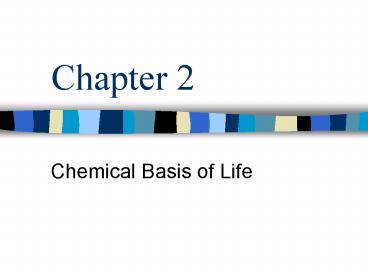Chemical Basis of Life - PowerPoint PPT Presentation
1 / 28
Title:
Chemical Basis of Life
Description:
All matter is composed of elements. Elements are the basic substances that ... The atoms must be highly electronegative (electron loving) like Oxygen, Flourine, ... – PowerPoint PPT presentation
Number of Views:19
Avg rating:3.0/5.0
Title: Chemical Basis of Life
1
Chapter 2
- Chemical Basis of Life
2
Matter
- Anything that has mass and takes up space.
- Atoms are the smallest particles of matter.
3
Elements and Atoms
- All matter is composed of elements
- Elements are the basic substances that make up
matter - Atoms are the smallest particles of matter
- Living Organisms require about twenty elements
- 95 of human body is made of oxygen, carbon,
hydrogen, and nitrogen
4
Atomic Structure
- Protons () 1amu
- Neutrons (neutral) 1amu
- Electrons (-) 1/1800 of a proton
5
Drawing Bohr Models of Atoms
6
Periodic Table of Elements
7
Periodic Table of Elements
8
Atom Rules
- of Protons Atomic number
- of Protons of Electrons
- Mass Protons Neutrons
9
Isotopes
- Isotopes have a different number of neutrons but
the same number of protons - Radio active isotopes are used to detect problems
with the thyroid, treat cancer, and detect
problem with digestion
10
Molecules and Compounds
- Molecule when two or more atoms combine
(usually for nonmetals) - Compound when two or more atoms of different
elements combine - Two types
- Ionic
- Covalent
11
Formulas
- Molecular formulas
- Represent the number atoms found in a compound
- Structural formulas
- Atoms of specific elements form a specific of
bonds - Shows the structure of the Chemical
12
Formulas
- Structural formulas for C4H9N
- Molecular formula is the same, but structural
formulas can vary
13
Bonding
- Atoms combine with other atoms to either gain
lose or share electrons - Electrons are found in shells outside of the
nucleus - Valence shell is involved in bonding and is the
outer most electron shell
14
Types of Bonding
- Ionic
- A metal and non metal
- Form ions
- Na
- O2-
- Transfer of electrons
- Ionic compounds
- Ions are important muscle contraction, nerve
impulse transmission, etc.
15
Types of Bonding
- Covalent
- 2 or more non metals
- Sharing of electrons forms a bond.
- Single double or triple
- Molecules formed when two or more atoms combine
16
Types of Bonding
- Hydrogen Bond
- Occurs when an atom of hydrogen has a strong
attraction to two atoms instead of one - The atoms must be highly electronegative
(electron loving) like Oxygen, Flourine,
Nitrogen, Chlorine and Bromine
17
Chemical Reactions
- When two or more substances come together to form
a new substance - Types
- Synthesis elements join to form 1 new substance
- Decomposition Substance breaks down into
components - Single Replacement 1 element in a compound is
exchanged for another free element - Double Replacement 2 elements in two compounds
are exchanged - Combustion Oxygen is used to burn a hydrocarbon
to produce carbon dioxide and water. (respiration)
18
Reversible reactions
- Product or products can convert back into the
reactants - The direction of reaction depends on several
factors - Energy
- Concentration of products
- Catalyst change the rate without being consumed
19
Acid Base Chemistry
- Electrolytes substances released into water that
produces ions and conducts electricity - Acids substances that release H
- Bases substances that release OH-
- Strong Acid Strong Base ? water and salt
- Example HCl NaOH ? H2O NaCl
20
pH Scale
- pH Scale Based on the concentration of H
(1-14) - pH of acid lt7
- pH of base gt7
- pH of neutral 7
- If blood pH is either below 6.9 or above 7.8 a
person cannot survive
21
Inorganic Substances
- Water
- Most abundant in living things
- Universal Solvent
- Most reactions occur in water
- Transports wastes, nutrients, etc
- Absorbs heat
- Oxygen
- Cellular respiration to release energy
- Carbon Dioxide
- Waste product of cellular respiration
- Salts
- Major sources on ions used in metabolic processes
- Na, Cl, K, Ca, Mg, P, CO3-2, HCO3-1, SO4-2
22
Organic Substances Carbohydrates
- Provides energy for activities
- C, H, O
- Ratio 121 (C6H12O6)
- Monosaccharides simple sugars (glucose)
- (Monomers)
- Disaccharides two simple sugars combined
together (lactose) - Polysaccharides complex carbohydrates (glycogen)
23
Organic Substances Carbohydrates
24
Organic Substances Lipids
- Insoluble in water
- Typically 3 fatty acids and 1 glycerol
(Triglycerides) - Store energy and have more energy
- Saturated max amount of Hydrogen
- Unsaturated not the maximum amount of Hydrogen
- Steroids complex rings that includes
cholesterol - Phospholipids cell membranes contain phosphate,
2 fatty acids and a glycerol.
25
Organic Molecules Lipids
26
Organic Molecules Lipids
27
Organic Substances Proteins
- Provide energy, structure, hormones, enzymes,
receptors, and antibodies. - Base unit amino acid
- 20 amino acids of which 12 are essential
- C, H, O, N
- Held together by hydrogen bonding so heat, pH
change, radiation, etc affect the bonding
28
Organic Substances Nucleic Acids
- Form genes and take part in protein synthesis
- DNA (Deoxyribonucleic Acid)
- RNA (Ribonucleic Acid)
- Nucleotides Adenine, Guanine, Cytosine,
Thymine(DNA only), and Uracil (RNA only)































